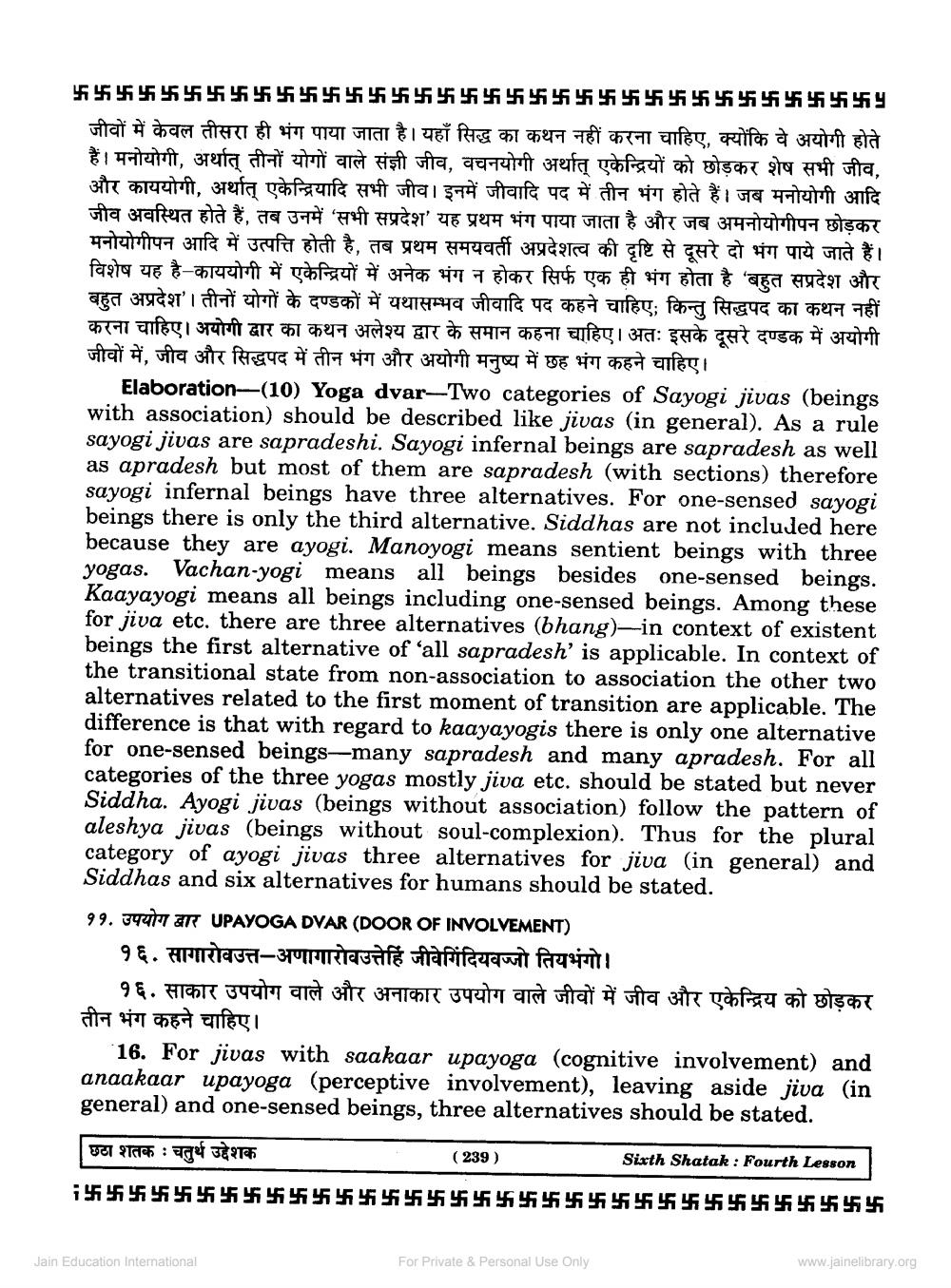________________
ज ) ) ) ) )) )) ))) )) ) ) ) ) )
जीवों में केवल तीसरा ही भंग पाया जाता है। यहाँ सिद्ध का कथन नहीं करना चाहिए, क्योंकि वे अयोगी होते हैं। मनोयोगी, अर्थात् तीनों योगों वाले संज्ञी जीव, वचनयोगी अर्थात् एकेन्द्रियों को छोड़कर शेष सभी जीव,
और काययोगी, अर्थात् एकेन्द्रियादि सभी जीव। इनमें जीवादि पद में तीन भंग होते हैं। जब मनोयोगी आदि जीव अवस्थित होते हैं, तब उनमें 'सभी सप्रदेश' यह प्रथम भंग पाया जाता है और जब अमनोयोगीपन छोड़कर मनोयोगीपन आदि में उत्पत्ति होती है, तब प्रथम समयवर्ती अप्रदेशत्व की दृष्टि से दूसरे दो भंग पाये जाते हैं। विशेष यह है-काययोगी में एकेन्द्रियों में अनेक भंग न होकर सिर्फ एक ही भंग होता है 'बहुत सप्रदेश और बहत अप्रदेश'। तीनों योगों के दण्डकों में यथासम्भव जीवादि पद कहने चाहिए: किन्त सिद्धपद का कथन नहीं करना चाहिए। अयोगी द्वार का कथन अलेश्य द्वार के समान कहना चाहिए। अतः इसके दूसरे दण्डक में अयोगी जीवों में, जीव और सिद्धपद में तीन भंग और अयोगी मनुष्य में छह भंग कहने चाहिए।
Elaboration-(10) Yoga dvar-Two categories of Sayogi jivas (beings with association) should be described like jivas (in general). As a rule sayogi jivas are sapradeshi. Sayogi infernal beings are sapradesh as well as apradesh but most of them are sapradesh (with sections) therefore sayogi infernal beings have three alternatives. For one-sensed sayogi beings there is only the third alternative. Siddhas are not included here because they are ayogi. Manoyogi means sentient beings with three yogas. Vachan-yogi means all beings besides one-sensed beings. Kaayayogi means all beings including one-sensed beings. Among these for jiva etc. there are three alternatives (bhang)-in context of existent beings the first alternative of 'all sapradesh' is applicable. In context of the transitional state from non-association to association the other two alternatives related to the first moment of transition are applicable. The difference is that with regard to kaayayogis there is only one alternative for one-sensed beings—many sapradesh and many apradesh. For all categories of the three yogas mostly jiva etc. should be stated but never Siddha. Ayogi jivas (beings without association) follow the pattern of aleshya jivas (beings without soul-complexion). Thus for the plural category of ayogi jivas three alternatives for jiva (in general) and Siddhas and six alternatives for humans should be stated. ११. उपयोग बार UPAYOGA DVAR (DOOR OF INVOLVEMENT)
१६. सागारोवउत्त-अणागारोवउत्तेहिं जीवेगिंदियवज्जो तियभंगो।
१६. साकार उपयोग वाले और अनाकार उपयोग वाले जीवों में जीव और एकेन्द्रिय को छोड़कर तीन भंग कहने चाहिए।
16. For jivas with saakaar upayoga (cognitive involvement) and anaakaar upayoga (perceptive involvement), leaving aside jiva (in general) and one-sensed beings, three alternatives should be stated.
छठा शतक : चतुर्थ उद्देशक
(239)
Sixth Shatak : Fourth Lesson
For Private & Personal Use Only
www.jainelibrary.org
Jain Education International




